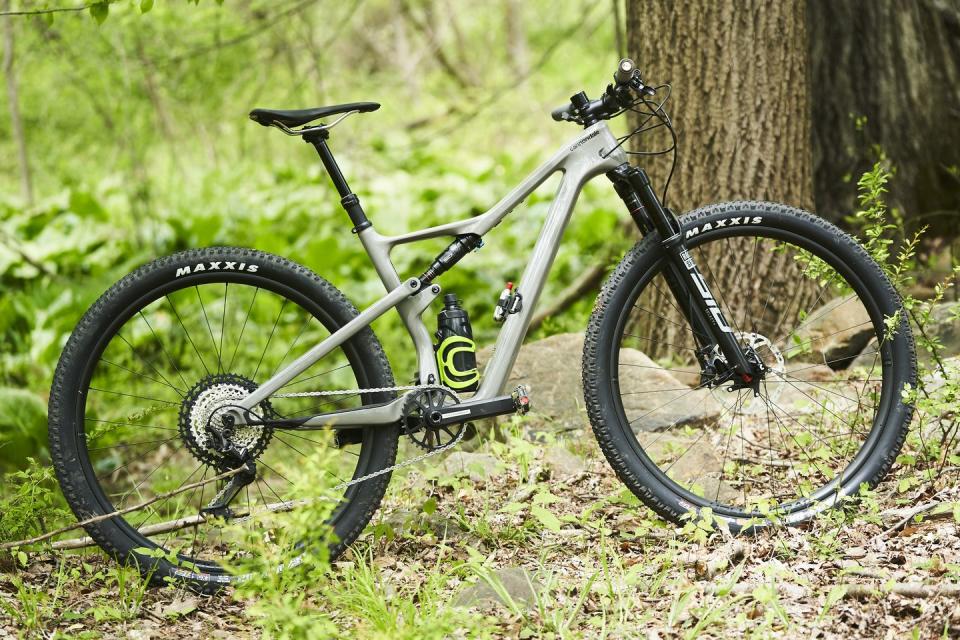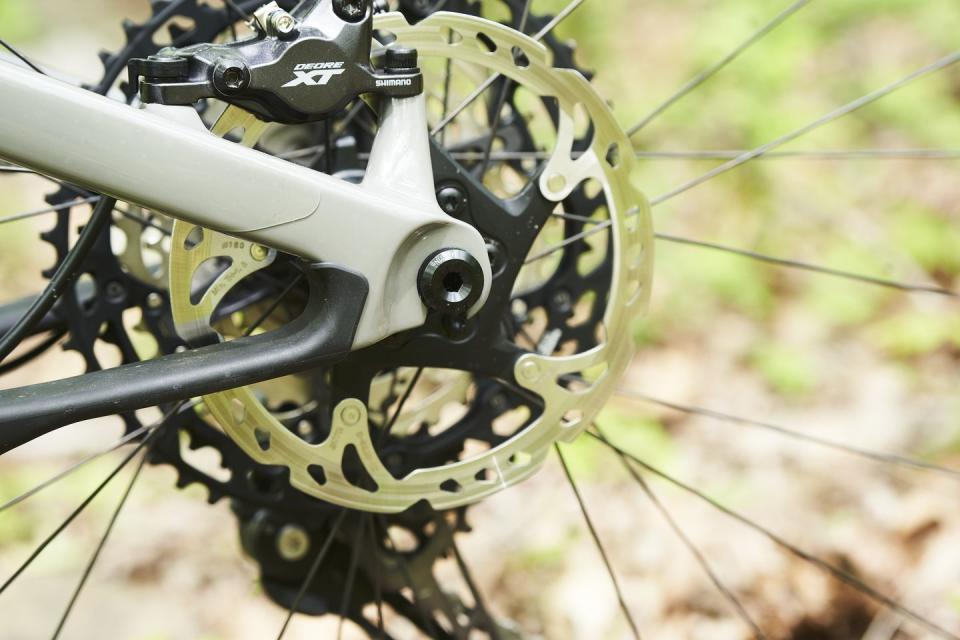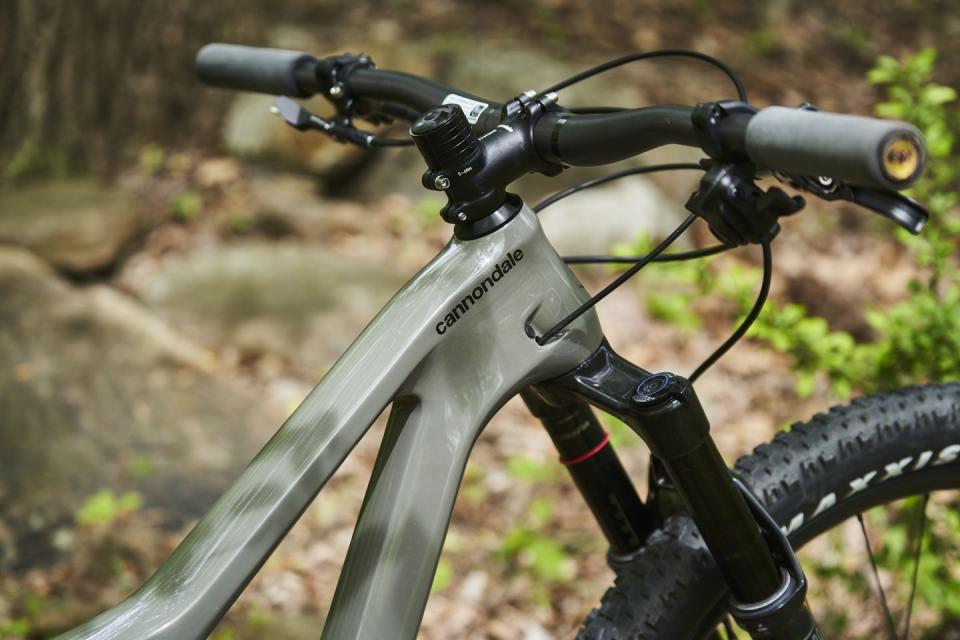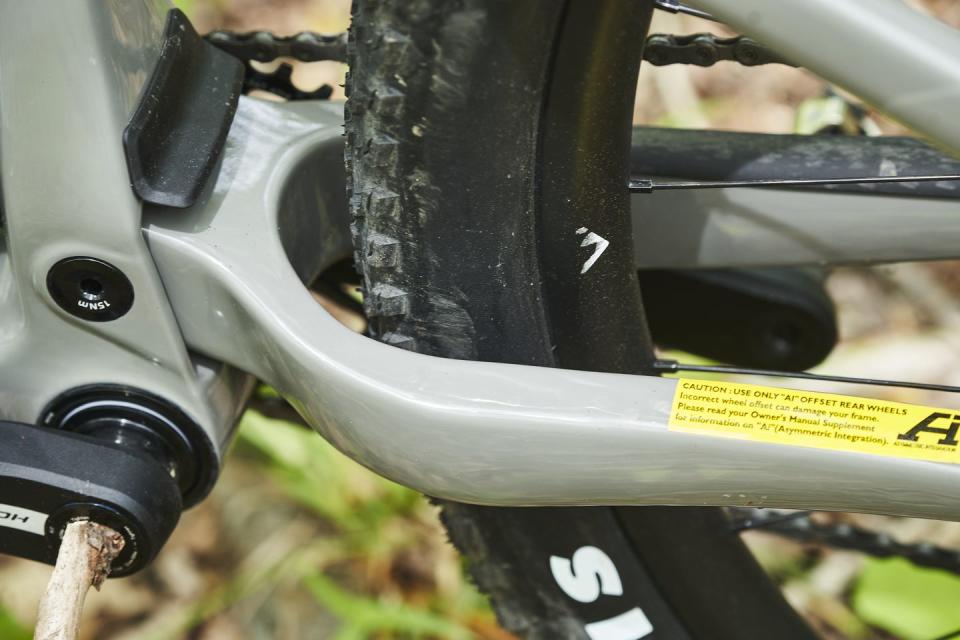Cannondale Scalpel SE 1 Hits the Sweet Spot Between Race and Trail
The Takeaway: The new Scalpel SE is a 120mm bike that’s XC-fast and trail bike-capable.
Unique suspension system without rear pivots saves weight
Updated geometry is in line with modern trail bikes
Shimano XT drivetrain and carbon Hollowgram wheels.
Price: $5,500 (Scalpel SE 1)
Weight: 27.25 lb. (XL)
MORE IMAGES
I’ve ridden my share of fast bikes with 120 or 130mm of travel but never had any desire to own one, until now. Personally, I prefer fast-handling, super-efficient racy bikes. Fun, capable, and rowdy are words we use to describe trail bikes, but we don’t expect to set any uphill KOMs on these do-it-all rigs. We talk about pedaling efficiency, but always with the understanding that it’s relative to other longer-travel full-suspension bikes.
The new Scalpel SE, however, really shakes that up and has me reconsidering what I want in my own ride and maybe what you should expect in your next one. It’s a full-suspension bike (120m of travel front and rear) that’s nearly as light (27.25 pounds for the XL) and agile as an XC bike but with the suds to let it run a little wild on the trails. And the unique suspension gives it a lively response to pedaling that I’ve only felt on one other bike, the BMC Fourstroke.

Cannondale’s New FlexPivot Suspension
The new Scalpel uses flex built into the carbon plates on the chainstays to control the 120mm of travel. The company calls it FlexPivot. While it’s not a new concept, Cannondale engineers were able to get some impressive results from the design. According to Cannondale Project Manager Scott Vogelmann, the platform offers performance similar to a traditional Horst Link suspension with the weight savings and simplicity of a single-pivot design. Vogelmann claims using carbon plates in the stays in lieu of rear pivots shaves about 200 grams off the weight of the frame. The brand’s engineers were quick to point out that this isn’t a flex stay like what’s on the Topstone Carbon, where the flex happens along the entire stay. The FlexPivot system isolates the movement to specific carbon plates. That gives us smooth rear suspension that’s XC light and efficient.
The redesigned frame is super light. Cannondale claims 1,910 grams for the frame, shock, and hardware (size medium), which it touts as the lightest mass-produced full-suspension frame on the market. Add on the RockShox SID Select+ RL fork and RockShox SIDLuxe Select+ shock and you’ve got a 120mm bike that’s insanely fast both uphill and down. It’s the daily rider for anyone who likes going XC fast on—and off—the course.
5 Things We Love About the Cannondale Scalpel SE
In-Frame Storage
Cannondale tucked a few other niceties into the frame. The Stash onboard storage system under the downtube water bottle mount holds a Fabric 8 in 1 multi-tool, as well as a Dynaplug tire-plug tool and a strap for a CO2 cartridge or frame pump. The lower pivots, previously located outside the seat tube where they were exposed to a lot of dirt and mud, are now tucked inside the tube. It’s a neat little design with a mud guard to help block grime coming off the rear wheel. And mechanics both home and professional will appreciate the tube-in-tube internal cable routing that eliminates the PIA factor of trying to fish a cable through the chainstay.

Scalpel SE Family
The SE 1 that we tested is hung with high-quality but high-value parts that keep it as light and fast as possible without driving the price tag into the stratosphere. The new SE 1 comes with RockShock’s excellent new SID fork, Shimano’s XT 12-speed drivetrain, and rolls on carbon Hollowgram 25 Superlight rims. If you are still left wondering about the high-speed intentions of this bike, you have only to look at the 34t chainring and the race-ready tires (2.35-inch Maxxis Ardent Race up front and 2.25-inch Maxxis Rekon Race rear) to see that this bike is outfitted with everything it needs to follow the flyweight XC bikes uphill.

The SE 2 and the SE 2 Women’s (both $4,000) roll on the same frame and shock as the SE 1 with a slightly downgraded fork (RockShox SID Select). SRAM’s SX Eagle is quality group, but a significant step down from Shimano’s XT. Both also use the same Stan’s NoTubes Crest S1 aluminum hoops. The women’s model gets a lavender frame color option and women’s saddle. Unlike the men’s version, it does not come in a size XL.
Cannondale Scalpel SE 1 Details
Style: Longer-travel XC
Material: Carbon
Wheel Size: 29er
Fork: 120mm RockShox SID Select+ RL
Shock: RockShox SIDLuxe Select+
Travel: 120mm
Drivetrain: Shimano XT 12-speed
Cranks: 175mm Hollowgram
Chainring: 34t
Cassette: 10-51
Brakes: Shimano XT hydraulic disc
Wheels: Tubeless-ready carbon Hollowgram 25 S Superlight
Tires: 2.35-inch Maxxis Ardent Race (front), 2.25-inch Maxxis Rekon Race (rear)
Saddle: Fabric Scoop Flat Elite
Seatpost: 150mm Cannondale DownLow dropper
Handlebar: 780mm Cannondale 1 Riser, carbon
Stem: Alloy Cannondale 1
Tire Clearance: 29 x 2.4 in.
Hybrid Trail and XC Geometry
Like many bikes, the Scalpel SE got longer/lower/slacker in its latest update. The head angle was kicked out to 67 degrees from 68.5 and the seat angle jumped up to 74 from 72 degrees. The bottom bracket dropped slightly to 344mm and the chainstay length remained unchanged at 436mm. The reach got longer—470mm for size XL is 20 mm longer than the previous generation—and the stack height dropped 6mm to 621mm. Cannondale offset the more aggressive stack by outfitting the SE with a riser bar to give it more of a trail bike feel.
A Blazing Fast Ride
The Scalpel SE looks the part of a trail bike, with relatively slack angles and a long-travel dropper post, and I had trouble believing this one could be a better daily rider than the XC bikes I prefer. However, I had only been in the woods 30 seconds before realizing there was something really special here.
The relaxed front end is apparent from the get go, as the front wheel likes to wander ever so slightly at low speed compared to more agile XC bikes. But I quickly became accustomed to that. Rear wheel traction is so good it felt like cheating—I could pedal full-gas over rocky trails with far less thought to line choice than normal. And unlike other bikes I’ve ridden that seem to absorb power from the pedals, the SE feels like those incredibly good ones that are so efficient and provide so much traction that it can feel as if they help propel you forward in some situations.

On tight, rocky trails, I frequently had pedal strike issues. Initially, I suspected a low bottom bracket, but it’s actually a full centimeter taller than the bottom bracket of the Scalpel-Si, my daily rider. The truth is I was riding faster and pedaling harder over terrain that previously caused me to be more judicious with line choice and pedal placement. On the SE, I was not just pedaling but accelerating through rock gardens that formerly took concerted effort to ride through cleanly. At the recommended 25 percent sag, the bike had excellent mid-stroke support and could handle repeated small hits at high speed while retaining good bottom-out support at the end of the stroke.

What wasn’t an issue was how fast this bike moves. On the six-mile test loop I use for all of my mountain bikes, I consistently completed the course well over a minute faster than any other bike I’d ridden on my home trails.
The SE rides so stinking fast that at times, it felt like my old brutally efficient XC bikes. But that’s not what this bike is for, really. There’s more travel and the suspension is tuned differently to be more active, and playful. That creates a really nice sweet spot for riders who like to pedal hard, but want something a little more capable that can be ridden everyday, on most trails. If that sounds like you, the new Scalpel SE delivers.
You Might Also Like

